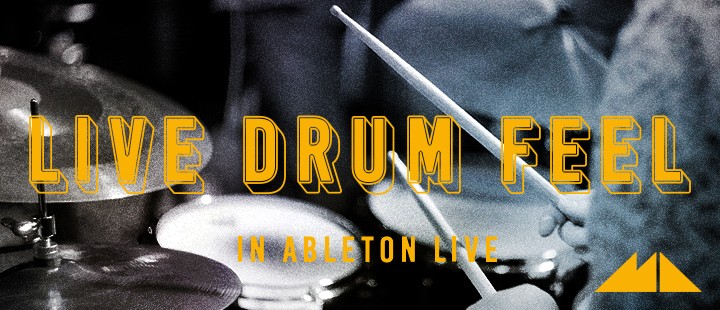
If you want to inject some live-feel into your drum production, most advice will tell you to either play the drums in yourself with quantization off, or to manually drag your MIDI/Audio clips off the grid inside your DAW after recording.
Playing the drums in yourself via MIDI keyboard/pads is a good option if you fancy yourself as a bit of a drummer, assuming you also don't have any latency issues in your recording process.
The other method of manually moving each clip so it's slightly off the beat can help with precision, but can end up being rather painstaking and time consuming.
Luckily for us, there is a third option offered in Ableton Live. It's quick, easy and can give you live-feel drums in no time. Let's check it out!
1. Find yourself a live drum loop with a nice, natural groove. We've got a great selection of drums within our catalogue, and in this example I've taken a loop from our Live Trip Hop Drums pack Smoke Signal:

You can hear the subtle swing in the groove and the varying velocities, particularly in the kick and ride parts. Now for the magic:
2. Right-click on your loop, and select 'Convert Drums to New MIDI Track' from the dropdown menu:

And voila! The magic elves inside Ableton just converted our drum loop into MIDI. In other words, we've just extracted the groove from the audio, and can now apply it to our own drum sounds.
In the conversion process, Ableton creates a new MIDI channel for us and automatically loads a 606 drum rack instrument into it. Let's have a listen:

Ok, its not absolutely perfect, but it's pretty close! Notice the variety in note velocities, as well as notes sounding slightly before or after the beat. We can also see this reflected on the MIDI piano roll if we zoom right in:

3. Now let's apply our own drum sounds to the MIDI by loading up our drum rack of choice. I'll use one from our Vinyl Drums - Vintage Drum Samples pack:
The groove is there, but the note velocities are not quite working at the moment. The kick hits too hard in places, the snare too soft, and some hi hats are hitting instead of kicks - so the conversion process was not completely accurate which is to be expected.
4. The last step is to get a bit surgical, correcting notes and fine-tuning velocities until we're happy. Let's have a listen:
And finally, let's hear it in context with some more loops. I've taken some instrumental loops from our latest Hip Hop pack Rusty Beats:
Sounding pretty good! Try it out yourself - make sure you start with a great, live-sounding loop that's not too busy and has plenty of feel. One click for conversion, then it's just a case of applying your own sounds and doing some finishing tweaks. Get into the groove!













